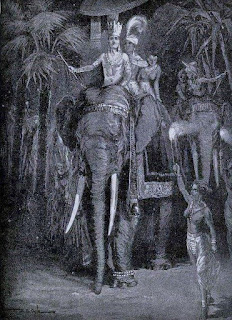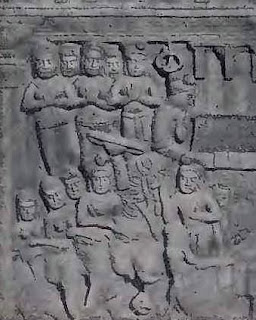King Ajatashatru also known as Kunika, was son of King Bimbisara
of the Haryanka Dynasty. He ruled Magadha from 491 to 461 BCE. He was very ambitious and a powerful king. King Ajatashatru
was a great warrior and a contemporary of both Mahavira and Gautama Buddha. He
forcefully took over the kingdom of Magadha from his father and imprisoned him.
Like his father, Ajatashatru also believed in the expansion of land and he followed
policies of conquest and expansion. Magadha extended its territories in almost
all the directions after the king Bimbisara’s rule and became the most powerful
kingdom in North India under the rule of Ajatashatru.
Birth
 Ajatashatru was referred as Vaidehi putra, in both
Jain and Buddhist inscription. According to Jain inscription, Ajatashatru was
born to King Bimbisara and Queen Chelna. According to Buddhist inscription
Ajatashatru was born to Bimbisara and Kosala Devi. But it is to be noted that both
the queens were called "Vaidehi" in both the inscriptions.
Ajatashatru was referred as Vaidehi putra, in both
Jain and Buddhist inscription. According to Jain inscription, Ajatashatru was
born to King Bimbisara and Queen Chelna. According to Buddhist inscription
Ajatashatru was born to Bimbisara and Kosala Devi. But it is to be noted that both
the queens were called "Vaidehi" in both the inscriptions.
In Childhood due to an infection Ajatashatru got a
boil on his little finger and the king Bimbisara sucked it and once while
sucking finger, the boil burst inside the king's mouth, but due to affection
for his child he did not spit the pus out, rather swallowed it.
The Jain records state that he had 8 wives, the foremost among them being Padmavati, Dharini and Subhadra, while the Buddhist traditions indicate that he had 500 wives, the chief being Princess Vajira. Both the Buddhists and Jain traditions say that he had a son, Udayabhadda or Udayabhadra.
The Jain records state that he had 8 wives, the foremost among them being Padmavati, Dharini and Subhadra, while the Buddhist traditions indicate that he had 500 wives, the chief being Princess Vajira. Both the Buddhists and Jain traditions say that he had a son, Udayabhadda or Udayabhadra.
Early Life
 Ajatashatru was poisoned by Devadatta (Gautam
Buddha’s cousin who tried to kill Buddha at several occasions) to kill his own
father. He forcefully took over the kingdom of Magadha from his father and
imprisoned him in 461 BCE. Rajagriha was the capital of Magadha and was
naturally fortified by 5 hills which stood surrounding the city. But it was
later changed to Pataligrama by Ajatashatru.
Ajatashatru was poisoned by Devadatta (Gautam
Buddha’s cousin who tried to kill Buddha at several occasions) to kill his own
father. He forcefully took over the kingdom of Magadha from his father and
imprisoned him in 461 BCE. Rajagriha was the capital of Magadha and was
naturally fortified by 5 hills which stood surrounding the city. But it was
later changed to Pataligrama by Ajatashatru.
As Bimbisara, father of Ajatashatru had conquered
the eastern state of Anga, Ajatashatru had concentrated towards the north and
the west. King Ajatshatru began his career of conquests by declaring war
against his own maternal uncle Prasenajit, the King of Kosala. The City of Kasi
was given to Bimbisara as dowry by Maha-kosala. After the murder of Bimbisara,
Prasenajit took the city back. This resulted in a war between Ajatashatru and
Prasenajit, in which Prasenajit was first defeated but became successful later.
As Ajatashatru happened to be his nephew, Prasenajit spared his life. In a
peace treaty Prasenajit married his daughter Vajira to him.
 He fought a war with Chetaka of Vaishali(Licchavi/Vrijji)
republic. The scythed chariot, a war chariot which had a blade on both ends of
the axle was invented by Ajatashatru and was used by him to fight against the
Licchavi Republic. The war continued for 16 years but in the end Ajatshatru
came out successful and Vaishali republic was annexed to the Magadhan Empire.
He fought a war with Chetaka of Vaishali(Licchavi/Vrijji)
republic. The scythed chariot, a war chariot which had a blade on both ends of
the axle was invented by Ajatashatru and was used by him to fight against the
Licchavi Republic. The war continued for 16 years but in the end Ajatshatru
came out successful and Vaishali republic was annexed to the Magadhan Empire.
Totally he had conquered 36 republics in and around
his kingdom and had established the supremacy of Magadha on whole of eastern
India.
Later Life
Ajatashatru’s early life was full of wars and
violence. But in the later part of his life, he filled his soul with grief and
repentance.
 It is somewhat difficult to say whether King
Ajatshatru was a Jain or a Buddhist by faith. The texts of both these religious
sects try to show him, like his father Bimbisara, as a follower of their
respective faiths. It is generally believed that perhaps he started as a
follower of Jainism but later on he changed his loyalty from Jainism to
Buddhism.
It is somewhat difficult to say whether King
Ajatshatru was a Jain or a Buddhist by faith. The texts of both these religious
sects try to show him, like his father Bimbisara, as a follower of their
respective faiths. It is generally believed that perhaps he started as a
follower of Jainism but later on he changed his loyalty from Jainism to
Buddhism.
In order to cleanse his heart from all sins, he
surrendered himself at the feet of Lord Buddha, where he found peace and he was
completely dedicated towards the Buddhist faith. His dedication was so complete
that he was made the chief claimant of Buddha’s relics after the death of Lord Buddha.
Ajatashatru subsequently built stupas all over the capital and renovated 18
monasteries in memory of Lord Buddha. He was the one who had established the
first Buddhist General Council in 487 B.C.
Death
He also suffered a fate similar to his father and
was assassinated by his son Udaybhadra in 461 BC.








0 Comments